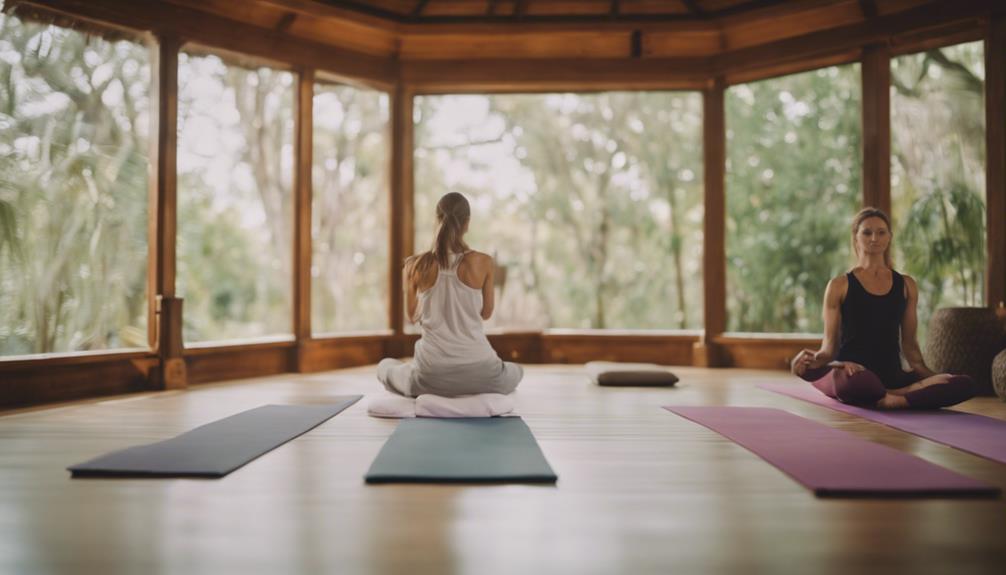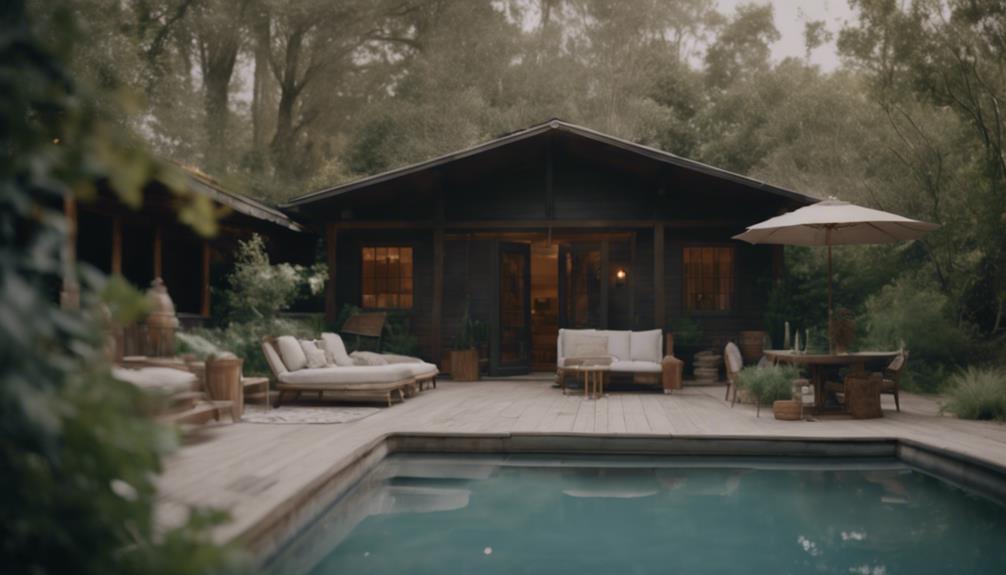Retreat development involves strategically designing and leading experiences that foster growth, reflection, and connection. As an aspiring facilitator, you’ll learn to set clear objectives, create engaging activities, and cultivate a safe, inclusive environment. You’ll focus on group dynamics, effective logistics, and meaningful content to guarantee participants gain insights and inspiration. Building these skills helps you craft transformative retreats that leave lasting impacts. If you want to master the art of retreat facilitation, explore further to discover more essential strategies.
Key Takeaways
- Retreat development involves planning and designing retreats that foster growth, reflection, connection, and personal or team transformation.
- It includes setting clear objectives, creating engaging activities, and designing a welcoming environment aligned with retreat goals.
- Facilitator development focuses on honing skills like active listening, empathy, managing group dynamics, and creating a safe space.
- Effective retreat development incorporates diverse formats, meaningful transitions, and storytelling to deepen participant engagement.
- Continuous improvement relies on feedback, evaluation, and reflection to enhance retreat quality and facilitator effectiveness.
Understanding the Purpose of Retreats

Understanding the purpose of retreats is essential because they serve as intentional breaks from daily routines to foster growth, reflection, and connection. When you participate in a retreat, you’re stepping away from everyday distractions to focus inward and on your relationships. These gatherings create space for self-awareness, allowing you to gain new perspectives and insights. They also promote bonding, helping you build stronger connections with others who share your interests or goals. By design, retreats encourage mindfulness and intentionality, enabling you to reset and recharge. Knowing why you’re attending helps you approach the experience with purpose, maximizing its benefits. Whether for personal development, spiritual growth, or team building, understanding the core purpose guides your expectations and engagement. Additionally, incorporating structured activities can enhance the overall effectiveness of the retreat experience.
Key Elements of Effective Retreat Planning

To plan an effective retreat, you need to set clear objectives that guide every decision you make. Engaging activity design is essential to keep participants involved and motivated throughout the event. When you align your goals with well-crafted activities, your retreat becomes more impactful and memorable. Additionally, understanding the importance of security measures can help protect sensitive participant information during the planning process. Incorporating diversification strategies from investment planning can also inspire creative approaches to balancing different retreat components for maximum effectiveness. Furthermore, considering interior design principles can enhance the physical environment, creating a welcoming and functional space that supports your retreat’s objectives.
Clear Objective Setting
Setting clear objectives is the foundation of a successful retreat, as it guides every aspect of planning and execution. When you define your goals from the start, you create a focused vision that shapes activities, logistics, and participant experience. Without clear objectives, your retreat risks losing direction and impact. Think about what you want attendees to feel, learn, or achieve. To help visualize this, consider the following:
| Emotion to Inspire | Desired Outcome |
|---|---|
| Connection | Strengthen team bonds |
| Inspiration | Spark new ideas |
| Reflection | Foster personal growth |
Additionally, understanding relationship dynamics can enhance facilitators’ ability to create meaningful interactions that deepen participant engagement and promote authentic connections. Recognizing dream symbols like emotional expressions or interactions can also inform how participants connect on a deeper level during the retreat. Developing a facilitator’s skill set that includes active listening and empathy can significantly improve overall retreat success. Incorporating digital literacy strategies can further enhance participant engagement and learning outcomes during your retreat. Moreover, aligning your objectives with Pimple Patch principles of targeted and effective treatment can help ensure your goals are both achievable and impactful.
Engaging Activity Design
Designing engaging activities begins with aligning them closely to your retreat’s objectives. You want participants to feel motivated, connected, and inspired, so each activity should serve a clear purpose. To create impactful experiences, consider these key elements: Relevance: Ensure activities resonate with your participants’ interests and goals, making them meaningful and memorable. Interactivity: Incorporate hands-on, participatory elements that encourage collaboration and active engagement. Variety: Mix different formats—such as discussions, exercises, and outdoor activities—to keep energy levels high and cater to diverse learning styles. Additionally, understanding the regulatory landscape of merchant services can help you design programs that are compliant and secure, thereby enhancing participant confidence. Being aware of cultural differences, such as varying holiday celebrations around the world, can also inspire creative activity themes that are inclusive and engaging for diverse groups. Incorporating sensory elements, like sounds and textures, can further deepen engagement and sensory experience for participants. Incorporating a variety of plant-based elements can also enhance the atmosphere and promote relaxation during activities.
Designing a Transformative Experience
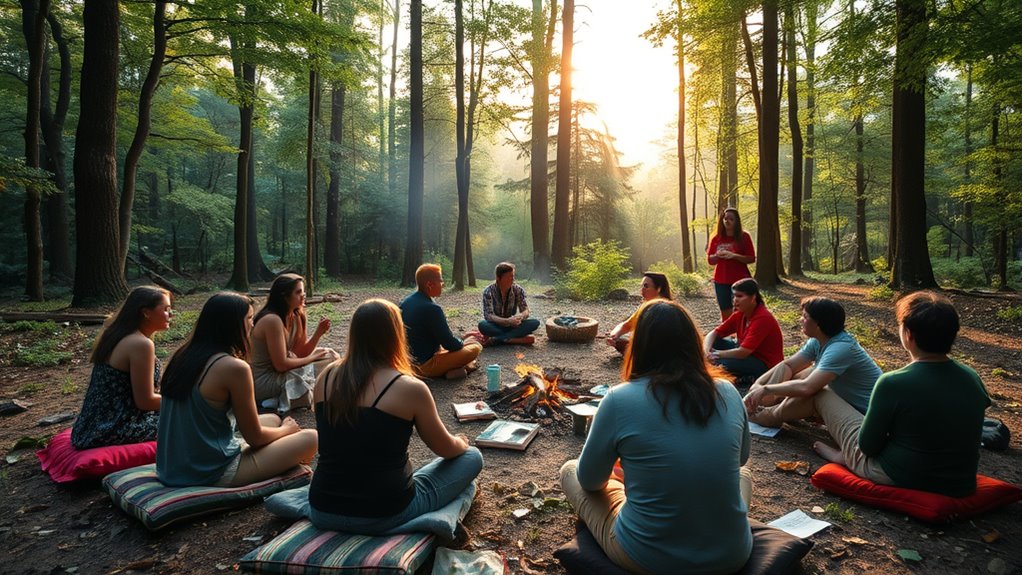
How can you create an experience that truly transforms participants? Focus on crafting moments that challenge, inspire, and foster deep reflection. Use storytelling, meaningful activities, and intentional silence to cultivate awareness. Design transitions that guide participants through emotional and cognitive shifts smoothly. To emphasize core themes, consider this approach:
| Element | Purpose | Example |
|---|---|---|
| Personal Reflection | Deepen self-awareness | Journaling exercises |
| Group Sharing | Build connection and trust | Facilitated dialogues |
| Experiential Activities | Engage emotions and senses | Nature walks, art creation |
| Silence | Foster inner listening | Guided meditations |
| Integration Time | Solidify insights | Group discussions, journaling |
Additionally, incorporating elements of AI automation can streamline the facilitation process and enhance personalized participant experiences. Integrating personal development principles can further deepen the transformative impact of the retreat.
Selecting the Right Environment and Logistics

Creating a transformative experience hinges not only on meaningful activities but also heavily depends on choosing the right environment and logistics. Your setting influences participants’ mindset and comfort, so select a location that fosters reflection and connection. Consider these key factors:
- Accessibility – Ensure the site is easy to reach for everyone, reducing stress and logistical hurdles. Facilitators should also consider the availability of facilities to support various activities effectively.
- Ambiance – Choose a peaceful, inspiring environment that aligns with your retreat’s purpose. An environment that encourages relaxation and focus can significantly enhance participants’ engagement.
- Facilities – Verify the availability of necessary amenities, like meeting spaces, accommodations, and outdoor areas, to support your agenda. Creating a supportive environment can also facilitate full attention during activities.
- Holistic Atmosphere – Incorporate elements that promote a sense of home and heritage, creating a welcoming space that nurtures well-being and connection. An environment that encourages symbol recognition can enhance participants’ ability to engage with deeper meanings in their experiences. Ensuring the environment aligns with your retreat’s goals can enhance participants’ overall experience and engagement.
Crafting Engaging Activities and Content

Engaging activities and compelling content are essential to transforming your retreat into a memorable experience. You want participants to feel inspired, connected, and motivated to grow. To do this, design activities that encourage participation and reflection, such as group discussions, hands-on exercises, or creative projects. Incorporate varied formats—workshops, games, or mindfulness practices—to keep energy levels high. Make sure your content aligns with your retreat’s overall goals and resonates with your audience’s interests. Use stories, real-life examples, and thought-provoking questions to deepen engagement. Remember, your goal is to foster meaningful interactions, so tailor activities to facilitate connection and learning. Integrating candle-making techniques can also serve as a creative activity that encourages focus and mindfulness. Well-crafted content and activities will ensure your retreat leaves a lasting impact on everyone involved.
Building a Supportive and Inclusive Atmosphere
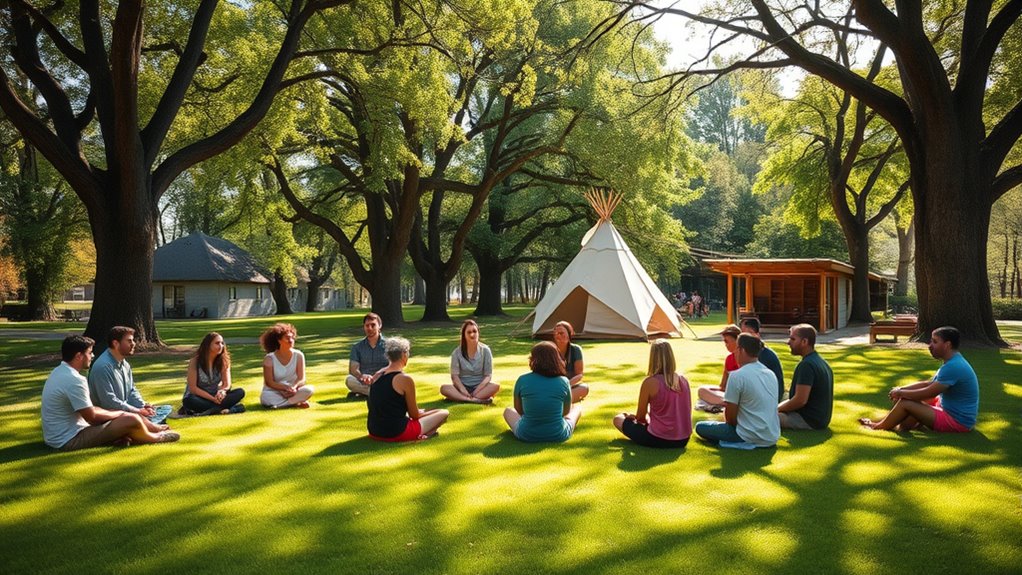
Building a supportive and inclusive atmosphere is essential to ensuring every participant feels valued and comfortable throughout your retreat. When participants feel safe and respected, they’re more likely to open up and engage fully. To foster this environment, consider these key strategies:
- Set clear ground rules that promote respect, confidentiality, and openness from the start.
- Use inclusive language and actively encourage diverse perspectives.
- Model empathy and active listening, showing genuine interest in each person’s experience.
Facilitating and Managing Group Dynamics
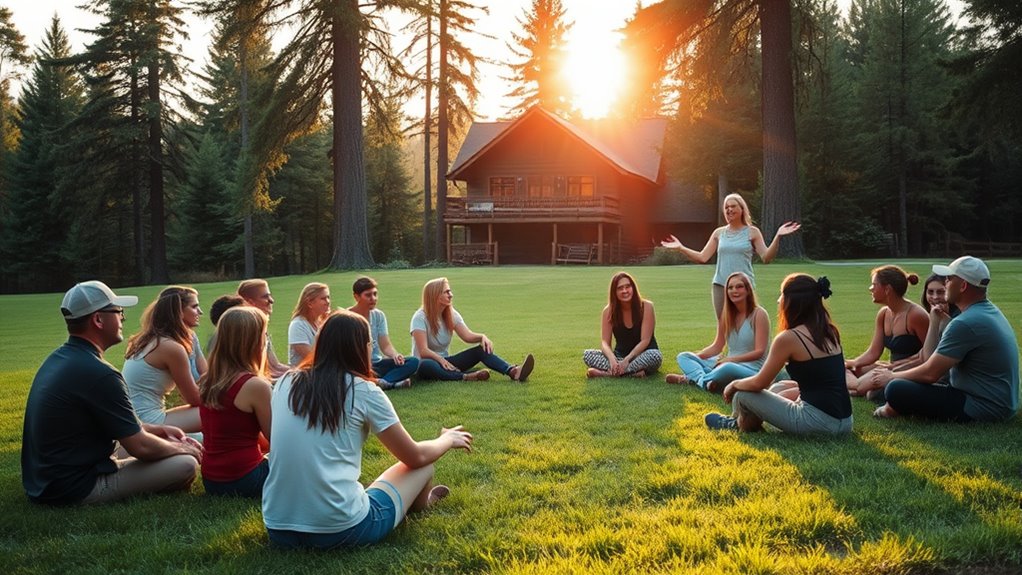
Managing group dynamics effectively is essential to maintaining a productive and harmonious retreat environment. Your role as a facilitator involves observing interactions, identifying emerging issues, and gently guiding conversations to stay on track. Keep an eye on participation levels—encouraging quieter members and managing dominant voices—to ensure everyone feels heard. Be attentive to non-verbal cues that may signal discomfort or disengagement. When conflicts arise, address them calmly and constructively, helping participants find common ground. Set clear expectations at the start, fostering respect and openness. Remember, your tone and body language influence the group’s atmosphere. By actively managing dynamics, you create a safe space where participants can share authentically and collaborate effectively, enriching the retreat experience for everyone involved.
Evaluating Success and Gathering Feedback

To determine whether your retreat has achieved its goals, you need to evaluate success and gather feedback systematically. This step helps you understand what worked well and what can enhance. Start by collecting feedback through surveys, asking participants to rate their experience and share suggestions. Next, analyze participation levels, noting attendance, engagement, and overall enthusiasm. Finally, reflect on your objectives—did participants leave with new insights, connections, or skills?
Here are three key actions:
- Distribute anonymous feedback forms immediately after the retreat.
- Review attendance and engagement data.
- Hold a debrief with your team to discuss observations and lessons learned.
This process ensures continuous improvement and better retreat experiences in the future.
Frequently Asked Questions
How Do I Price My Retreat Services Competitively?
To price your retreat services competitively, research what others in your niche charge and consider your unique offerings. Determine your costs, including venue, supplies, and your time, then add a fair profit margin. Offer tiered pricing or early bird discounts to attract different budgets. Keep in mind that pricing too low might undervalue your experience, while too high could deter potential attendees. Balance value and affordability to find the sweet spot.
What Legal Considerations Should I Be Aware Of?
When planning your retreat, you should be aware of legal considerations like liability waivers, permits, and insurance. Make sure you draft clear contracts for participants, outlining expectations and cancellations. Check local regulations for health and safety codes, especially if you’re serving food or hosting activities. Consulting a legal professional can help you navigate licensing requirements and protect your business, ensuring your retreat runs smoothly and safely.
How Can I Market My Retreats Effectively?
To market your retreats effectively, you need to identify your target audience and craft compelling messages that resonate with them. Use social media platforms, create a user-friendly website, and leverage testimonials to build trust. Collaborate with local businesses or influencers to expand your reach. Consistently share valuable content, engage with your community, and offer early-bird discounts or special packages to boost bookings and generate buzz around your retreats.
What Skills Are Essential for Effective Facilitation?
You need strong communication skills to clearly convey your ideas and listen actively to participants. Emotional intelligence helps you understand and respond to diverse needs, creating a safe environment. Flexibility allows you to adapt plans as needed, while leadership skills guide the group effectively. Patience and empathy foster trust, and organization keeps the retreat running smoothly. Cultivating these skills guarantees your facilitation is engaging, inclusive, and impactful.
How Do I Handle Difficult Participants During a Retreat?
When dealing with difficult participants, remember that you’re in the driver’s seat. Stay calm and listen actively, showing empathy without taking things personally. Set clear boundaries and address issues promptly, making it clear what behavior is acceptable. Sometimes, a simple acknowledgment of their feelings can defuse tension. If needed, take a break or redirect focus. Handling challenges head-on keeps the retreat productive and everyone feeling heard.
Conclusion
As you step into retreat development, remember that every detail aligns to create a meaningful experience—sometimes, the perfect environment appears just when you need it, and the right activity unexpectedly sparks transformation. Trust your instincts and stay flexible, because success often comes from these serendipitous moments. Keep learning, adapting, and embracing the surprises along the way. In doing so, you’ll craft retreats that leave lasting impacts—sometimes, the most unexpected elements become the most memorable.



